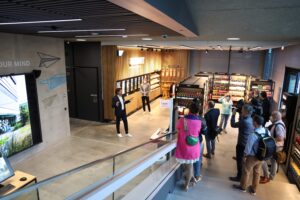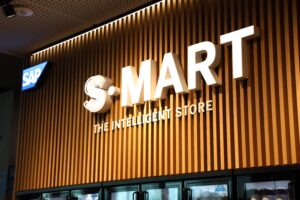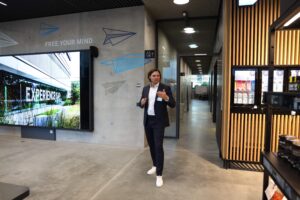The reopening of the SAP Experience Center in Walldorf has ushered in the next generation of SAP innovation spaces designed to enable a personalized and up-close journey into the added value of SAP software.
Media representatives, customers, and SAP employees came together in person when the center opened its doors again in October. Created in 2019, the center had undergone several months of redesign and refurbishment to reflect enhancements to SAP’s customer experience (CX) strategy for the 26 SAP Experience Centers it operates worldwide – a strategy that will now be rolled out incrementally to all of them.
Speaking at the ribbon-cutting ceremony in Walldorf, SAP CEO Christian Klein talked about SAP’s place in the world of today: helping customers across the globe find solutions for highly complex business processes. He shared his conviction that SAP solutions were making a key contribution to tackling the immense challenges humanity currently faced – not least climate change, high inflation, and energy security issues. Nevertheless, for many, its contribution was intangible and hard to visualize. What SAP needed, said Klein, was to find ways of showing its software in action.

Bringing the Benefits of SAP Solutions to Life
That task falls to Andre Bechtold, who, as head of Value Experience at SAP, is responsible for the SAP Experience Center Walldorf. In the search for ways to showcase SAP software, he and his team refined the SAP Experience Center strategy. “The benefits of SAP solutions are not always obvious to customers,” Bechtold said. The aim of the refined strategy was, quite simply, to bring innovations closer to visitors and to tailor their experience to their specific industry and business needs.
The idea behind the center is to bring the benefits of SAP solutions to life – whatever industry or sector a customer operates in. The team at the center prepares personalized presentations to suit each client. What’s more, instead of using generic storylines to demo certain showcases, content teams now create a tailored storyline for each customer, even paying close attention to details such as the company logo, lighting levels, and the floor layout. Virtual sessions are also available to help customers reduce their carbon footprint.
Customers who visit the center can opt to see an overview of all SAP solutions – and even test them live. This is possible because many customers are already connected to SAP through the partner network. As Bechtold pointed out, “This allows them to experience the potential for innovation and the benefits SAP solutions offer – in their own value chain.”
The experience lab at the SAP Experience Center in Walldorf focuses on the retail industry, offering an interactive look at the innovations SAP is currently working on with its customers and partners to make supply chains more transparent, resilient, and sustainable.
“Almost no one knows their CO2 footprint today,” said Klein at the reopening, which also attracted a lot of media interest. One of SAP’s aims, he added, was therefore to work with customers and partners to create the largest global business network of intelligent and sustainable enterprises. This network already comprises several million trading partners and enables transparency along the entire supply chain. It also provides an environment for co-innovation between customers and partners. The “S.MART” store at the experience lab is just one example of this collaboration.
Experience the Future of Shopping – Today!
S.MART, the intelligent supermarket of the future, is designed to present a real-life example of an intelligent enterprise – and to give customers a personalized, end-to-end experience. As they walk along the supermarket aisles, they can watch the latest SAP and partner solutions in action and see the possible benefits with their own eyes.
The S.MART supermarket is fitted with sensors and cameras that are connected to the SAP system and SAP ecosystem. A dashboard records all the data these sensors and cameras capture, analyzes it, and displays it as actionable insight for store managers. They in turn can see at a glance how many customers are currently in the store, which products are running low, and how many items of each product are left on the shelves. They can also see whether products have been placed on the wrong shelf. Armed with that knowledge, the managers can send push messages to store personnel and avoid costly shelf gaps.
Also showcased in S.MART are electronic shelf labels, which enable store managers to update product prices remotely with a single click of the mouse in the back-end system and sensors that monitor the temperature in refrigeration equipment and send alerts when issues arise, which saves energy and money and is also vital for ensuring food safety.
QR codes are used at S.MART to provide customers with more product information. People with allergies and special dietary needs, for example, can enter criteria in a dietary app of their choice. When they scan the QR code for a product, they immediately receive information on whether that item fits their dietary preferences or not. QR codes can also be used to provide details about a product’s origin or carbon footprint. The aim of services like these is to offer added value and transparency, and thus strengthen customer loyalty.
Cameras allow retailers to (anonymously) analyze customer behavior and even compile age and gender profiles of a store’s clientele. This makes it possible to address specific customer groups, helps with pricing, and provides insight into the best place to position promotional material and products.
In the future, cameras will also help eliminate the need for customers to stand in line at checkout. SAP is working on the corresponding technology with various partners, including Israel-based tech company Trigo. With retailers now also struggling to recruit staff, smart systems like this could provide a welcome solution. On the issue of whether they can be tricked and will make shoplifting easier, Bechtold seemed unconcerned: “Shoplifting is a fact of life. The question is, will it increase or decrease in the future? The smart camera systems are really good. We tried everything we could think of to catch them – and failed. I even tried putting my shopping in someone else’s bag. But it was still correctly charged to me.”
Photos by Konrad Berger






